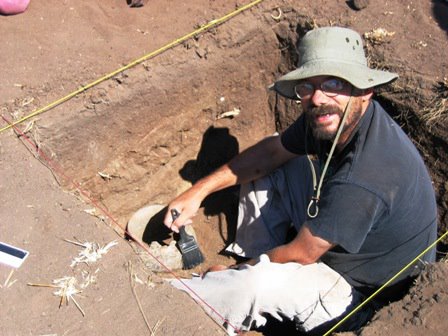This morning’s symposium on "Human Behavioral Ecology and California Archaeology" at the Society for California Archaeology meetings comprised a number of papers on the use, abuse and differenting perspectives on the nature of evolutionary ecology models for interpreting the archaeological record. Much of this started a year or so ago, with the argument put forth by Kelly McGuire and Bill Hildebrand (both friends of mine) that the ascendancy of artiodoctyl hunting in California might have arisen not, as some suggest, as the result of simple caloric returns (larger mammals are a bigger package of meat, and therefore more “worth the effort” to find, hunt and process them than are smaller animals like rabbits), but rather as the advent of “signaling” by individual hunters, who through increased hunting success, “signal” to females that they are good providers and should therefore seek them as mates. (McGuire sardonically referred to the latter idea this morning as the “meat for sex” model!).
Regardless of which side of the debate one falls on (and a good range of issues on both sides was discussed) several things struck me listening to the papers this morning. The first is that archaeology is clearly a scientific discipline – there is far more to it than just digging square holes in the ground! All papers presented clearly presented well-developed theoretical approaches, which also clearly guided collection and interpretation of the data itself. The link between solid theory, hypothesis testing and data interpretation could not have been stronger. I have always argued that this is the true nature of archaeological research (developing a theoretical structure in which to frame and test problems is as critical as data recovery), but it was highly satisfying to see the two mesh so well this morning.
The symposium also highlighted the fact that the best innovations in archaeological thinking and interpretation derive from the rigorous application of evolutionary theory. Other theoretical perspectives have been tried, but explanations of archaeological data are best explained by evolutionary theory. I would argue that the advancement of “Syro-Palestinian” archaeology (read “Bible” archaeology) would also be better served by a solid dose of evolutionary theory instead of a misguided depdendence on humanly written texts (another discussion, I suppose….).
To the extent that the symposium demonstrated archaeology’s commitment to interpretation of data within a rigorously defined theory, it also showed archaeology’s commitment to science. Over and over again, I heard the broad “If/Then” statements so critical to developing testable hypotheses and then actually demonstrating whether or not the data fit the expectations suggested by the model. I couldn’t help but think of the great extent to which Intelligent Design is both theory and data derived. Papers presented this morning generally took the following form:
1) Here are the basic concepts behind theoretical approach X;
2) If theoretical approach X is an appropriate model, we would expect A, B and C in the archaeological record;
3) Here are the data from the archaeological record;
4) Data are best explained by the proposed model; or if not, it was identified precisely where the theoretical approach or the data may not have been adequate, or fit the expectations of a different model;
5) Here’s where additional research would be helpful;
In contrast, I would bet that the upcoming Darwin vs. Design Conference will proceed more along these lines:
1) Darwin/evolution/natural selection is bad;
2) Darwin/evolution/natural selection is bad and wrong;
3) Darwin/evolution/natural selection is bad, wrong, and has a deleterious effect on morals;
4) Therefore, we should all accept Intelligent Design.
I was also reminded that when McGuire and Hildebrand proposed the idea of signaling as a better explanation for certain archaeological trends we were seeing in California, they received a significant drubbing from the foraging theory community. In response, McGuire and Hildebrand did not whine about the “militant foraging theorists” dominating the discipline, write op-ed pieces for the various newspapers complaining about how they were being picked on, or outright lie about the nature of foraging theory. Instead, they wrote additional papers, clarifying their ideas, responding to specific arguments and more importantly, they developed testable hypotheses and collected more data. Whether or not they have offered a better theoretical approach, the fact that 13 scientists got together this morning to present data and tests on the idea of “meat for sex” shows that they are successfully engaging in that most precious commodity that still eludes Intelligent Design: good science.
Subscribe to:
Post Comments (Atom)




1 comment:
very interesting to read
Post a Comment